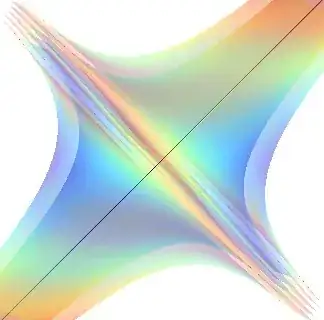Let $$J=\pmatrix{0&1&0\\0&0&1\\1&0&0} \ \ \text{with} \ \ J^2=\pmatrix{0&0&1\\1&0&0\\0&1&0}\tag{1}$$
and
$$J^3=I \tag{2}$$
Consider the set $S$ of $3 \times 3$ "circulant" matrices :
$$M_{a,b,c}:=aI+bJ+cJ^2=\pmatrix{a&b&c\\c&a&b\\b&c&a}\tag{3}$$
Please note that $$\det(M_{a,b,c})=a^3+b^3+c^3-3abc\tag{4}$$
$S$ is stable by multiplication, due to property (2). Indeed :
$$(aI+bJ+cJ^2)(a'I+b'J+c'J^2)=$$
$$(aa'+bc'+b'c)I+(ab'+ba'+cc')J+(ac'+bb'+a'c)J^2\tag{5}$$
In other words:
$$M_{a,b,c} \times M_{a',b',c'}=M_{(aa'+bc'+b'c),(ab'+ba'+cc'),(ac'+bb'+a'c)}\tag{6}$$
Taking the determinant on both sides of (6) and applying (4), one can conclude to the stability by multiplication. Of course, the above operations, when done with entries in $\mathbb{Z}$, give back entries in $\mathbb{Z}$.
Remark 1: Properties (1) and (2) for $J$ have a natural interpretation as (cyclic) permutation matrices.
Remark 2: One can check easily that set $S$ has all the required properties for being a (unitary) ring for matrix addition and multiplication. Can this ring be turned into a field ? If this was possible, by isomorphism, (the additive group of $S$ is isomorphic to the group $(\mathbb{R}^3,+)$), it would imply that $(\mathbb{R}^3,+,\times)$ can be turned into a field. But we know it is impossible by a theorem due to Frobenius. What is missing ? The fact that some elements haven't an inverse, more precisely those with
$$\underbrace{x^3+y^3+z^3-3xyz}_{\det M_{x,y,z}}=0\tag{7}$$
A classical factorization of the LHS is
$$(x+y+z)((x-y)^2+(y-z)^2+(z-x)^2)=0\tag{8}$$
A consequence of (8) is that the set of non-invertible matrices $M_{x,y,z}$ is the union of
$$\begin{cases}\text{a plane : } x+y+z=0\\
\text{a line : } x=y=z\end{cases},\tag{9}$$
otherwise said to 2 families of matrices :
$$\begin{cases}\pmatrix{x&y&-x-y\\-x-y&x&y\\y&-x-y&x} \text{rank 2 matrices,}\\
\pmatrix{x&x&x\\x&x&x\\x&x&x} \text{rank 1 matrices} \end{cases}\tag{9'}$$
I have investigated in a graphical way the relative "positions" of the families of matrices $M_{x,y,z}$ such that
$$x^3+y^3+z^3-3xyz = k$$
for different values of constant $k$.
The result is displayed on the figure below under the form of "russian dolls" surfaces, a kind of "foliation" of space $\mathbb{R^3}$ ; in a progressive manner, these surfaces "take their distance" wrt the degenerate case, with plane $x+y+z=0$ as their asymptotic plane, and a chimney-like part around the line $x=y=z$ (featured in black).

Fig. 1 : Surfaces $x^3+y^3+z^3-3xyz = k$ for $k=-8,-4,0,4,8$.
Edit : All these surfaces are surfaces of revolution around the line defined in (9) as established in this answer.
